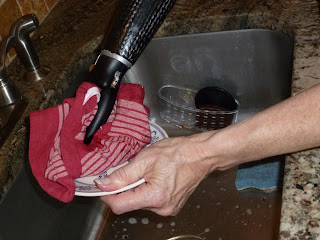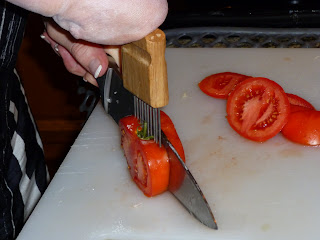My husband loves to eat and I love to cook for him. Since I was chopping, mixing ingredients and indulging in a stovetop creation, we thought it was a great time to seize the moment and add to the blog. So, thanks to my husband Mike and his camera, we have the next edition to How Do You Do... Cooking! I also want to take a moment to speak about learning to cook. Like everyone else from my generation, I took the obligatory Home Ec in 7th and 8th grades. Unfortunately, Mrs. P's rigid lessons did not unleash any culinary desires -or talents- in my heart. That being said, I had a wonderful Chemistry teacher in the 10th grade (Mr. B!) who ignited my interest in creating and encouraged my tendency to use my prosthesis in inventive ways.
-The hook does a
wonderful job holding test tubes over a bunson burner. Tonight I am making a pasta primavera with shrimp. I admit it; I'm cleaning out the refrigerator but it really did turn out good!
Before we get started, let's take a peak at some of my favorite cooking tools (though we may not use all of them in today's edition):
my non-skid mat (purchased at HomeGoods)
white anti-microbial cutting boards (Ikea)
one-handed pizza roller (Pampered Chef; used to cut more than pizza)
one-handed pie crust roller (ditto)
double-blade scissors/spoon (a gift!)
Kitchen Aid grater with lid (HomeGoods)
egg yolk separator (Pampered Chef)
bamboo tongs (Pampered Chef)
food pick (Pampered Chef)
And the cooking begins!
I place the non-skid mat on the counter with my cutting board on top of it. This keeps the cutting board from sliding around while I'm trying to chop. Then I use my forearm to stabilize the onion to cut off the ends...
With the prosthesis:
or without:
Then I peel the onion:
and then chop it:
Without a prosthesis, this is how I do it...
I am using my residual limb to push down on the blade. -It does look a little dangerous, but I am very cautious (and at this point in my life) pretty quick.
Add it to the saute pan -with olive oil, of course (and garlic, spices...)
I love the handle on my cutting boards. It's just big enough to slide my residual arm in place to grab the board. Now it's time to chop the tomato. Tomatoes are typically softer and can be squishy. -It's definitely an advantage to use my Adept over the hook with this task!
and certainly more difficult (but possible!) without...
It's even easier with the food pick:
Chop, chop, chop!!!!
Another way to chop is the double-blade scissors device:
And add it to the saute pan:
Now to make the pasta. First, fill the pot with water. It's much easier to keep the pot on the counter if possible, rather than filling it in the sink and lifting it up onto the counter. I place it on a cutting board so I can slide the full pot over to the sink and then onto the stove.
Same steps without a prosthesis: slide the full pot on the counter and place the pot on the stove.
The pasta is done... To move the hot pot to the sink I keep the cover on and gently move it onto the cuttingboard and slide it over to the sink.
Without a prosthesis,
I wear an oven mitt on my residual limb:
My colander has expandable handles that stretch over the sink and I dump the hot pasta and water into it...
Dinner is almost ready, but I need to open a jar of seasoning to add to my concoction
and then peel the shrimp...
I use the tongs for serving and hold my plate in my prosthesis -or place it alongside the serving dish...
Bon appetit!
We'll have alot of dishes to wash in the next edition...




















































